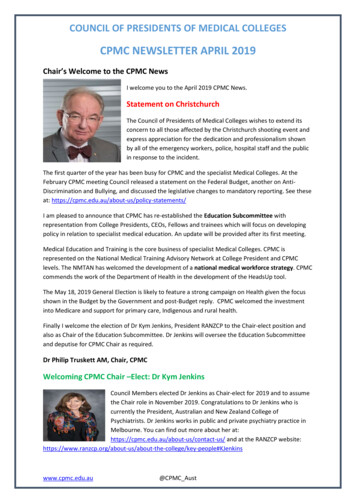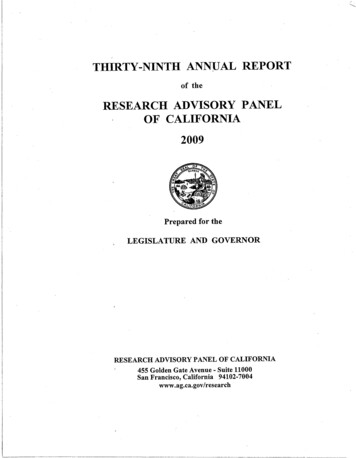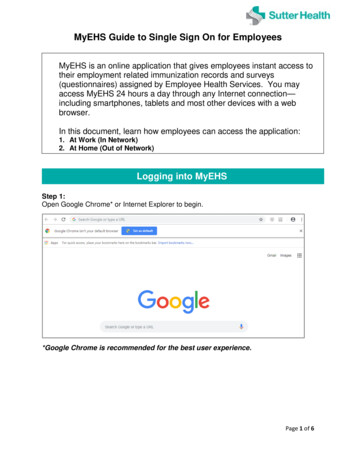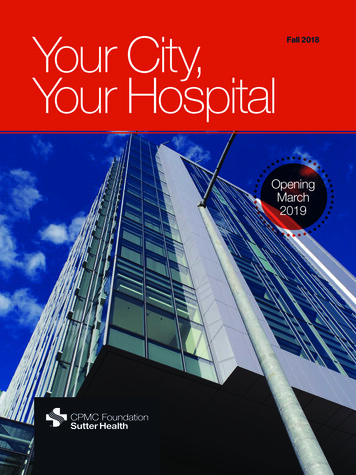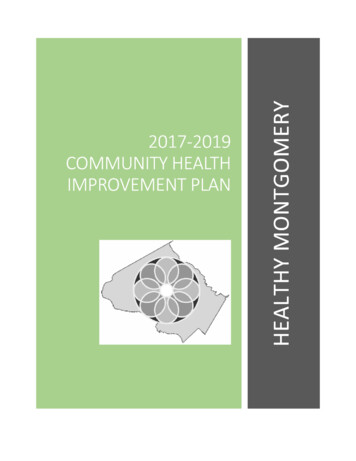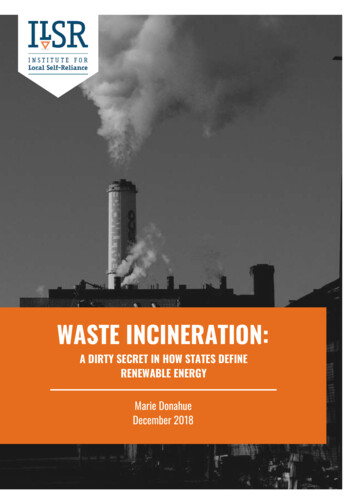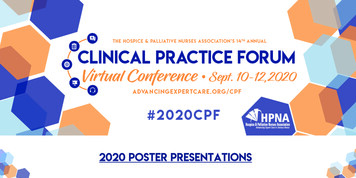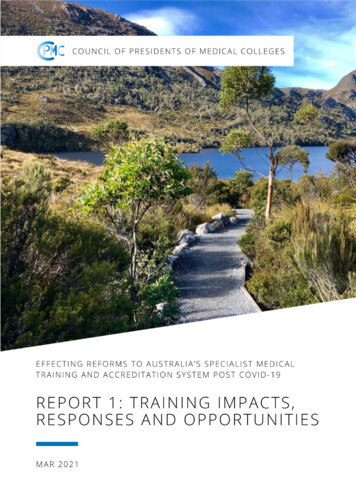
Transcription
1
ACKNOWLEDGEMENTSEffecting Reforms to Australia’s Specialist Medical Training and Accreditation System Post COVID-19 isa joint project of the Council of Presidents of Medical Colleges (CPMC) and the Australian MedicalCouncil (AMC). The project is funded by the Australian Government Department of Health.The CPMC established the Education and Medical Workforce Subcommittee (EMWS) in 2020 tooversee their work on the project. CPMC wishes to thank the members: Dr Kym Jenkins, Chair, Council of Presidents of Medical Colleges (CPMC)Prof Julian Archer, Executive General Manager Education, Royal Australasian College ofSurgeons (RACS)Ms Robyn Burley, Executive General Manager Education, Learning and Assessment, RoyalAustralasian College of Physicians (RACP)A/Prof Phil Carson, Censor-in-Chief, Royal Australasian College of Surgeons (RACS)Dr Sarah Chalmers, President, Australian College of Rural and Remote Medicine (ACRRM)Prof. John Nicholls, Royal College of Pathologists of Australasia (RCPA)Dr Nick O'Connor, Board Member, Royal Australian and New Zealand College of Psychiatrists(RANZCP)Dr Karen Price, President, Royal Australian College of General Practitioners (RACGP)Dr Vijay Roach, President, Royal Australian and New Zealand College of Obstetricians andGynaecologists, (RANZCOG)Dr Andrew Robinson, Registrar, Royal Australian and New Zealand College of Psychiatrists(RANZCP)Ms Melanie Saba, Chief Executive Officer, Royal Australasian College of MedicalA/Prof. Alan Sandford, President, Royal Australasian College of Medical Administrators(RACMA)A/Prof Leonie Watterson, Councillor, Australian and New Zealand College of Anaesthetists(ANZCA)Stakeholder consultation and report preparation was done by the CPMC project team, led by MsAngela Magarry (CPMC CEO) and comprising Ms Krista Recsei (Project Manager) and Ms AnneFredrickson (Research Officer).Cover photo by Mohamad Ibrahim, sourced on Unsplash2
TABLE OF CONTENTSACKNOWLEDGEMENTS . 21. EXECUTIVE SUMMARY . 42. INTRODUCTION . 23. METHOD AND RESULTS . 33.1 STAKEHOLDER IDENTIFICATION . 33.2. SURVEY DEVELOPMENT AND DATA COLLECTION. 33.3 THEMATIC ANALYSIS . 44. DISCUSSION . 74.1 TRAINING REQUIREMENTS . 74.2 EDUCATION DELIVERY . 94.3 WELLBEING. 124.4 CLINICAL PRACTICE . 144.5 OTHER . 155. CONCLUSION . 17REFERENCES . 20APPENDIX A: KEY STAKEHOLDERS . 22APPENDIX B: STAKEHOLDER SURVEY . 243
1. EXECUTIVE SUMMARYOrganisations across the Australian medical training system have rapidly adapted to continue coreoperations during the COVID-19 pandemic. This experience of disruption and their collectiveresponses present an opportunity for learning and reform.This report is the second output of the Effecting Reforms to Australia’s Specialist Medical Training andAccreditation System Post COVID-19 project (the project). It is the result of extensive consultationwith key stakeholders on issues they have faced during the pandemic, how they have responded, andwhat could be taken forward to provide a more flexible and responsive system.These stakeholders represent the whole training pathway, including medical schools, membershiporganisations, regulators, specialist medical colleges and health departments. Completed written orphone surveys were received from 32 of the 43 stakeholders, a response rate of 74.4%.Interview responses were coded thematically using the four key themes - training requirements,education delivery, wellbeing and clinical practice - and 37 subthemes. These were initially identifiedin the project's first output, a literature review on the impact of COVID-19 on medical educationworldwide.While the Australasian experience was found to overlap with that of the mainly internationalliterature from the review, there were some important differences. In our survey responses, theimpacts on clinical practice were not widely mentioned. Conversely, some novel and notablesubthemes emerged: Business operationsCommunicationCrisis planningEquity (rural and remote)Exams and wellbeingSociality and collegialityTravel restrictionsWorkforce planningSeveral of these issues have existed in the specialist medical training system for some time, with theCOVID-19 pandemic bringing them into prominence or highlighting flow-on effects.Respondents also reported implementing positive solutions and adaptations such as: De-centralised, modular examsMore flexibility for exam deferrals, attempts, and feesTemporary waivers on training requirements and special consideration for provisionalprogressionReducing or waiving training feesIncreased teaching, training time, and monitoringUse of telehealthUse of tele/videoconferencing for education and meetingsCentralised and frequent communication initiatives4
However, some outstanding issues remain: Exam timing, format and delivery, including the role of high-stakes barrier examsTrainees not fulfilling requirements/progressing and the resulting backlog of trainees,workforce shortages or inadequately prepared workforceThe lack of evaluation of virtual systems for clinical care (telehealth), exam delivery andeducation delivery, including the potential loss of bedside knowledge, peer support andcollegialityWorkforce maldistribution and the reliance on IMGs/fly-in-fly-out staff in rural and remoteareasTrainee wellbeing and the underlying issues of high workloads, high stakes assessments andnegative workplace culturesThe lack of risk planning to account for the possibility of future pandemics, natural disastersor other national/global disruptions.Implementing solutions to these complex issues will require coordination across the organisationsinvolved in specialist medical training pathways. The next output of the Project will put forward policyand practice recommendations.1
2. INTRODUCTIONThe COVID-19 pandemic continues to have unprecedented impact on population health and tochallenge health system management globally. The medical training system in Australia is noexception, with organisations across the training pathway rapidly adapting to keep operations runningwhile ensuring the safety of staff and patients. For example: Medical schools moved classes online, allowing students stuck overseas to access learningWorkplaces redeployed trainees to respiratory clinics and other areas of projected need, andprovided PPE trainingSpecialist medical colleges (colleges) paused some training requirements and moved examsonline to allow trainees to progressRegulators adjusted accreditation processes for colleges and workplacesThe Effecting Reforms to Australia’s Specialist Medical Training and Accreditation System Post COVID19 project (the project) is harnessing the opportunity for learning and reform. It is investigating theimpact of the pandemic on medical training and accreditation, as well as the adaptations that havebeen made in response.It will provide recommendations for improvements based on these findings, including by informingthe National Medical Workforce Strategy. These improvements will be aimed at addressing issuescaused or exacerbated by the pandemic, as well as ensuring that positive adaptations and innovationsare maintained.Report 1: Training impacts, responses and opportunities is the project’s second output. It is the resultof extensive consultation with key stakeholders on issues they have faced during the pandemic, howthey have responded, and what can be taken forward to provide a more flexible and responsivesystem. As discussed above, this report will be used to inform future recommendations.This report was guided by the key themes and subthemes identified through the project’s first output,a literature review on the global adaptations in medical education due to COVID-19.2
3. METHOD AND RESULTS3.1 STAKEHOLDER IDENTIFICATIONKey stakeholders to be surveyed were initially proposed by the CPMC project team. This list wasreviewed and added to by the AMC project team and the CPMC Education and Medical WorkforceSubcommittee (EMWS).The sampling frame comprised organisations from the breadth of the medical training pathway: Medical schoolsMembership organisations (including trainee membership organisations)Regulators (Australia and New Zealand)Specialist medical colleges (Australia and New Zealand)State and national health departmentsNew Zealand-based organisations were included as the two health systems are connected in manyways, including through the 13 bi-national specialist medical colleges. Rural clinical schools wereincluded through the Medical Deans of Australia and New Zealand (MDANZ), who consulted with ruralclinical schools and included those perspectives in their survey responses. The full list of stakeholdersinvited to respond (N 43) can be viewed in Appendix A: Key stakeholders.3.2. SURVEY DEVELOPMENT AND DATA COLLECTIONSurvey questions were developed by the project team and reviewed by the AMC project team andCPMC EMWS. The final open-ended qualitative questionnaire was used for both online and phoneresponses. This full questionnaire template can be seen in Appendix B: Stakeholder survey.The focus of the survey was on specialist training, but views were sought from across the medicaltraining pathway. This includes responses submitted from MDANZ and the Australian MedicalAssociation Council of Doctors in Training.Regulatory bodiesMembership groupsHealth departments and othergovernmentSpecialist medical colleges0Responses received5101520Total stakeholdersFigure 1: Stakeholder survey completion, excluding multiple responses and including combinedresponses.3
The questionnaire was sent to stakeholders via email, with instructions that responses would be deidentified and aggregated to provide confidentiality. Those who did not respond were sent a followup email five weeks later, which included an offer to conduct the survey over the phone.Completed surveys were received from 32 of the 43 stakeholders, a response rate of 74.4%.Responses are summarised in Figure 1 and further information on respondents can be found inAppendix A: Key stakeholders.Four stakeholders returned multiple responses from different staff members. A consolidatedresponse was received from the three stakeholders. In total, 34 responses were received from 32stakeholders. Of the stakeholder categories, membership groups had the lowest response rate with43% of invited stakeholders completing surveys (despite multiple attempts to schedule phoneinterviews). Specialist medical colleges had the highest response rate, with 84% of invitedstakeholders submitting responses.3.3 THEMATIC ANALYSISInterview responses were coded thematically, focusing on how the medical training system has dealtwith the barriers and obstacles to progression through training pathways, and how can these beeliminated or modulated to provide a more flexible and responsive system.Survey responses were coded iteratively using NVivo, a qualitative research software package, by aproject team member with extensive experience and training in qualitative analysis. The codebookwas initially drawn from the draft (December 2020) National Medical Workforce Strategy’s fivepriority areas and three themes, shown in Table 1. However, the themes developed from these areaswere found to be too broad to assist with analysis, as the majority of responses fell under “Reformingthe training pathways,” without further granularity.Priority areasThemesCollaborate on planning and designGrowing the Aboriginal and Torres Strait Islanderworkforce and improving cultural safetyRebalance supply and distributionReforming the training pathwaysAdapting to changing models of careBuilding generalist capabilityImproving doctor well-beingA medical workforce that is supported to thrive andtrain and work flexiblyTable 1: National Medical Workforce Strategy priority areas and themes, December 2020A second stage of coding used a codebook produced from the four themes and 37 sub-themesidentified in a literature review completed as the first stage of the project, Impacts of COVID-19 onPostgraduate Medical Education. These are shown in Figure 2 below. While a majority of theliterature review’s subthemes were found to some degree in the survey data, only the mostprominent themes in the data are discussed in this report.Additionally, themes or sub-themes that emerged from the data and did not fit within the areas inFigure 2 were noted as possible new themes and discussed by two members of the project team. If anagreement was reached that a new code should be created to reflect this theme, it was applied to allsurvey responses where appropriate. Agreement was reached in all cases, and new subthemes can beseen in Figure 3.4
Training requirementsEducation delivery Changes to accreditation requirements Risk of not meeting requirements (volume of practice, logbooks) Exams postponed or moved online Conferences cancelled (lost opportunities for trainees to present) Research impacted (positive and negative impacts) Role of clinical competency committees Bridging gaps in training Areas identified for further training Application processes - move to video interviews Application processes - equity of application process Rapid transfer on-line Accessibility / capacity for broader reach, including access to expertpresenters Forcing innovation and reform Proliferation of online resources Use of new technologies Pros and cons of virtual delivery Opportunities to enhance feedback to trainees with online modalities Uptake of simulation Maintaining quality of materialWellbeing Measurement of psychological distress, anxiety, depression Dealing with stress and uncertainty Risk of exposure to self, family and friends Inadequate PPE supplies and impacts on trainee wellbeing Financial considerations (including future job prospects) Strategies to address (wellbeing programs, services) Equity (other responsibilities, childcare) Positive impacts (being part of a team, sense of purpose, mission)Clinical practice Rapid adaptation Ceasing rotations (stay in place orders) Redeployment, particularly to critical care areas, COVID-19 wards Segregated rostering Decreased volume of practice Decreased breadth of exposure Most senior person primary operator Changes to other clinical activities Balancing service versus training Unplanned learning opportunitiesFigure 2: Themes and sub-themes as identified by the Impacts of COVID-19 on Postgraduate MedicalEducation literature review.5
TrainingrequirementsEducation deliveryWellbeingClinical practiceOther* Changes to exam format and delivery Risk of not meeting requirements Travel restrictions* Forcing innovation and change Pros and cons of virtual delivery Sociality and collegiality* Rapid transfer online Attitudes to new technology and change Equity - rural and remote* Business operations* Stress and uncertainty Exams and wellbeing* Work and culture* Financial considerations Communication* Decreases in experience Ceasing rotations (stay in place orders) Redeployment Workforce planning* Crisis planning*Figure 3: Themes and sub-themes as identified by survey analysis - new areas indicated with *.6
4. DISCUSSIONOverall, the themes in the survey responses paralleled those identified in the literature review. At thetime of this project, the majority of publications on COVID’s impacts on medical training reflected theNorth American system. As Australia had lower case numbers and a different national andjurisdictional response, concerns that Australian respondents brought to these themes diverged fromthe literature in several ways. These are most notable in the new subthemes.These differences and the most prominent themes and sub-themes in the data are discussed below.New themes and sub-themes not previously identified in the literature are also highlighted (seeFigure 3, which represents the revised framework for our analysis). Brief commentary is given on theissues in the literature that are less represented in our sample.Salient verbatim responses have been provided from the survey data to reinforce the analysis of eachsub-theme below. These have been de-identified and labelled according to the category ofrespondent: HD: health department or other governmentMG: membership group (including trainee organisations)RG: regulatory bodySMC: specialist medical college4.1 TRAINING REQUIREMENTS4.1.1 CHANGES TO EXAM FORMAT AND DELIVERYWhile a reduction in trainees’ procedural work was noted as a major concern in the existing (chieflyNorth American) literature [1-5], the impact on exams was less represented. Our respondentshighlighted that changes to the timing, format, and delivery of exams constituted one of the largestchallenges created by the pandemic in the Australian training system. The medical examinationsystem relied heavily on centralised face-to-face exams, many of which took place only once or twiceper year. Exam development, in some cases, also involved in-person meetings. Travel restrictions,lockdowns, and physical distancing requirements upended this system starting in March 2020.Most organisations surveyed reported responding to this challenge by offering de-centralisedmodular exams supplemented with tele- and/or videoconferencing. In some cases, a localised paperexam was offered within a “COVID-safe” environment. However, aspects of clinical assessment forsome respondents could not be satisfactorily adapted to a virtual format or held in a COVID-safemanner. Instead, they have been delayed until face-to-face assessment is possible. Respondentscommented that this has a particular impact on overseas-trained doctors seeking registration inAustralia, as well as trainees granted conditional advancement on the proviso of meeting theserequirements at a yet-to-be-determined time.“Management of examiner and trainee expectations has been difficult. There have beenvariations is what each group feel is possible. Examiners are more focused on staying thecourse and delivering the exam as close to normal, and trainees are happy to acceptvariations as long as the exams occur.” (SMC7)7
The organisational strain of rapidly shifting assessment to a secure virtual format, including in vivoaspects, also appears to have stretched the limit of many organisations’ staffing, IT, and financialresources. The delays, uncertainties, and exam failures were noted as a major cause of stress andanxiety for trainees. This was around both exams and training progression (see Section 3,“Wellbeing,” for more). The flow-on effects for progression continue to present planning difficultiesfor training providers and employers, who report a potential backlog of trainees and delay inprogression to fellowship.“It would be helpful to have some standardised reporting from medical colleges around theoutcomes of training such as how many trainees have entered and exited training and atwhat stage. Having this information would enable health departments to understand theimpact of COVID on training and plan for future disruptions.” (HD2)Several institutions noted that exam pass rates improved slightly in 2020, possibly due to increasedpreparation time and/or the online setting. However, many respondents indicated that providers andtrainees prefer to return to the face-to-face model of examination as soon as possible. Acknowledgingthe uncertainty of this possibility, however, respondents are planning for the continuation of onlineexams into 2021, as well as considering high-stakes assessment as a priority for reform. The risks andharms of pressurised exam systems are well-documented [6-10], and several respondents highlightedhow the pandemic invites more consideration of alternative models of examination, such as workbased assessment.“Questioning barrier exams and thinking more about work-based and other assessmentmethods will likely lead to big improvements to training.” (MG3)4.1.2 RISK OF NOT MEETING REQUIREMENTSDelays and changes to exams overlap with the more general issue of trainees’ fulfilling trainingrequirements, the second major sub-theme in this area. Respondents reported that the disruptionand/or cancellation of mandatory training elements including clinical placements, rotations,workshops, and simulation courses forced many organisations to put in place temporary waivers,provisional progression, and special consideration policies. Other providers responded by extendingtraining time as opposed to changing requirements. Several respondents noted the support of theregulators in enacting these changes.Regardless of the approach, respondents stressed that any modifications introduced were intendedas temporary, with several noting ongoing monitoring to ensure that changes did not result in arelaxation of standards. Many respondents acknowledged the ongoing uncertainty regardingprovisional advancement—often conditioned on future successful completion of yet-to-be scheduledclinical exams (see sub-theme above). How this issue will progress in the face of potential futurelockdowns and/or distancing requirements is yet to be resolved.“The jurisdictional experience is one of a loss of trainees to a national training program whoare based interstate and only rotate into the state for a limited period as directed by aCollege, then return to their home state. [This has] a negative impact on local workforcesustainability and supervisor/trainers become demoralised and burn out, as they sense theyare not contributing to local workforce development.” (HD4)8
While the pandemic has created delays to training progression worldwide [11-13], a new sub-themeemerged from our respondents that appears to be unique to Australia: the impact of domestic travelrestrictions. The immediate impact of state border closures was most pronounced for rural andremote areas, which rely more heavily on a non-local and non-resident workforce. Cross-borderrequirements for many training programs were also affected. Trainees were unable to travel to otherstates for rotations, interviews, and exams (as were examiners). Some respondents noted that theirorganisations successfully lobbied for travel exemptions and/or recognition of trainees as “essentialworkers” (a classification that allowed for more travel freedoms during state lockdowns). Yet, therewas no universal approach to this issue, as there has been no universal approach to state andterritory lockdowns in Australia.“The border closures and travel requirements exacerbated the existing challenges of havinga non-local and non-resident workforce. Trainees and registrars coming from interstate tochange or continue jobs either couldn’t, or had their move interrupted by quarantine orrestrictions on clinical work at their rural site.” (HD5)International travel restrictions, for both Australians and international medical graduates (IMGs), havealso complicated training progression. A number of respondents noted that Australian trainees whowere completing placements overseas have still been unable to return to Australia, while the delaysfor IMGs to enter into the training pathway have resulted in workforce gaps. Several respondentslinked the domestic and international travel restrictions with this larger, pre-existing issue ofworkforce planning and sustainability, which relies heavily on cross-state and international travel (see“Workforce planning,” below).“International students and trainees who were overseas at the onset of the pandemic havebeen unable to return to Australia. The long-term impact on graduate and Fellow numbers isunknown.” (HD1)4.1.3 OTHER SUB-THEMESThe majority of survey responses regarding training requirements focused on the areas above, butseveral respondents also reported that the required pivot to video interviews for junior medicalofficer (JMO) recruitment and selection into training streamlined the application process, wasreceived well by applicants, and resulted in time and cost efficiencies. Similarly, organisations involvedin accreditation have moved towards virtual site visits and assessments, freeing up capacity to dealwith the more urgent COVID-related priorities. Some respondents indicated they were consideringcontinuing virtual accreditation post-pandemic, or a hybrid model, due to the time and cost savings.4.2 EDUCATION DELIVERY4.2.1 FORCING INNOVATION AND CHANGEMany respondents commented that although capacity for online education modalities has existed forsome time, it was not until the pandemic that organisations were forced to engage with theseoptions. This information reflects a new finding from our survey data: that the proliferation of virtualdelivery has impacted attitudes toward new technologies as well as their uptake.“We all were a bit complacent before the pandemic. Although we had a focus onimproving quality, there was also a business-as-usual model . Organisations talked aboutefficiency and there were attempts on the periphery about what this means, but no one9
delved into this in a major way to create change, such as moving to videoconferencing,which could have been done many years ago.” (RG1)This is not to suggest that online education has been wholly embraced—in fact, many respondentshighlighted tensions from virtual methods not proven or perceived as equally valid as face-to-faceteaching (see “Pros and cons of virtual delivery,” below). Others, however, reported that the positiveoutcomes of online education (increased pass rates, more engagement, savings in costs andefficiencies, etc.), as well as increased exposure to these technologies, has shifted opinions which mayhave otherwise remained fixed.“The pandemic has demonstrated that high quality training outcomes can be met in differentways. Many aspects of medical education that were considered unquestionable, have beenquestioned by necessity and alternative approaches found. Many requisites of training werebased on tradition rather than evidence.” (HD1)The pace and scale of virtual delivery in the pandemic appears to have strained the staffing and ITresources of education providers. Adjusting to remote settings, working with limited bandwidth andtechnological knowledge, and rapidly overhauling decades of in-person training into an online format(telehealth, supervision, assessments, interviews, etc.) was frequently noted as an ongoing challengefor organisations (see “Business operations,” below).“The quick nature of change has meant long hours for staff to meet tight deadlines. Nothaving a precedence or experience to draw on meant a lot of processes had to be developedfrom scratch.” (SMC1)4.2.2 PROS AND CONS OF VIRTUAL DELIVERYRespondents uniformly acknowledged the benefits offered by online education’s flexibility andaccessibility. Many organisations noted increases in both attendance and engagement in virtualevents compared to face-to-face training, and some reported increases in exam pass rates in 2020.The variety of educators available for training was also highlighted as a strength, as online formatsrendered previous geographic constraints obsolete. The use of telehealth was praised as a model thatshould continue. Respondents also recognised that more training is needed in telehealth, particularlyas it relates to supervision. Several respondents reported that virtual delivery may also amelioratewhat is perceived as a “training gap” for trainees in rural and remote areas.“The feedback [on virtual delivery] has been overwhelmingly positive. We will look toenhance our delivery of the training program in 2021 based on the success of 2020. It wouldbe difficult to revert back to the ‘pre-pandemic’ delivery model as several aspects of onlineeducation, webinars and virtual supervisor workshops were very well attended.” (SMC1)There is a divergence between trainee feedback on virtual delivery and the perceptions of educatorsand examiners. While many respondents reported positive feedback from trainees, the effectivenessand validity of online education continues to be a point of debate among providers. These concernsfocus chiefly on the virtual learning environment ma
a joint project of the Council of Presidents of Medical Colleges (CPMC) and the Australian Medical Council (AMC). The project is funded by the Australian Government Department of Health. . education delivery, wellbeing and clinical practice - and 37 subthemes . These were initially identified in the project's first output, a literature review .
